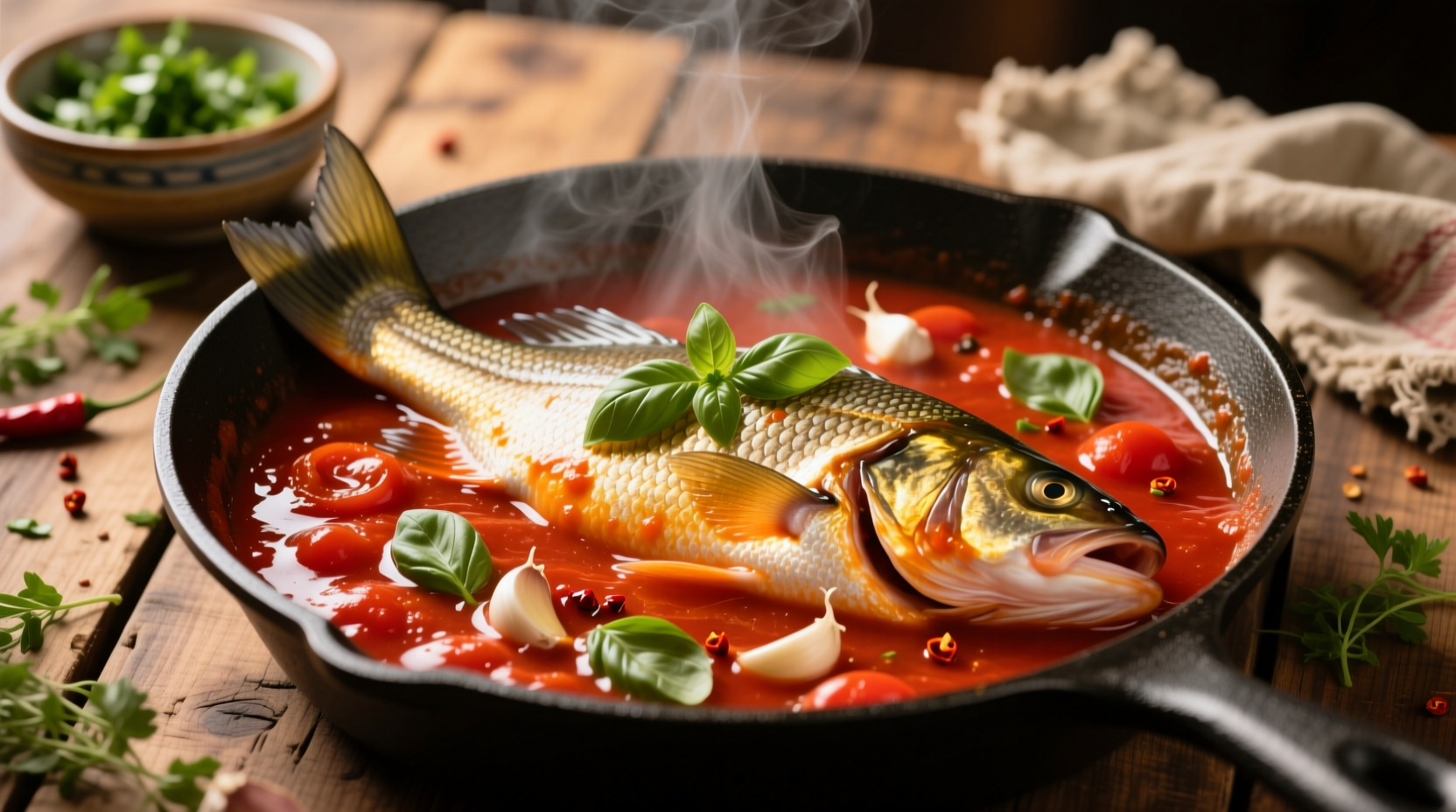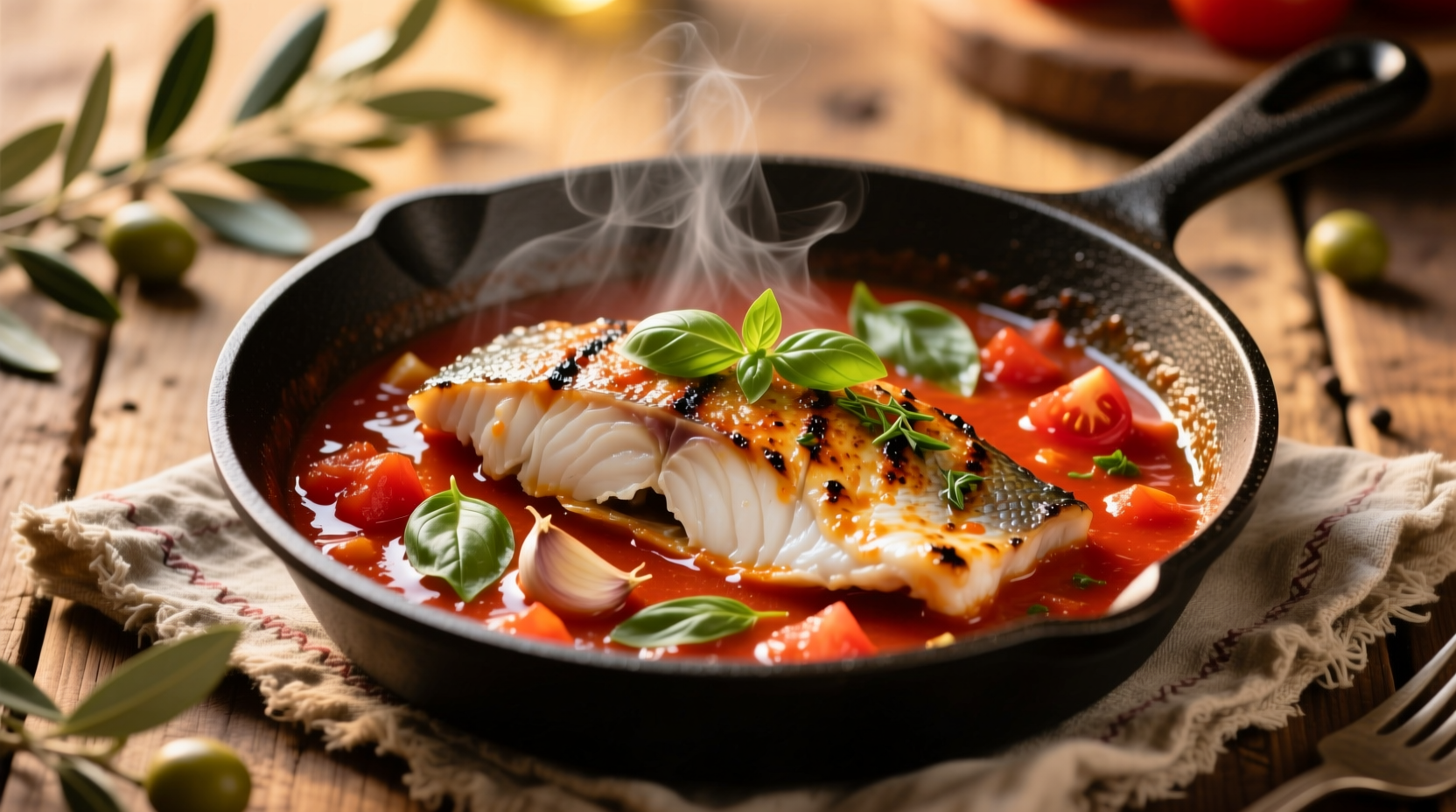Fish in tomato sauce is a versatile Mediterranean and Latin American dish featuring fresh fish simmered in a rich tomato-based sauce with aromatic herbs and spices. The perfect preparation yields tender fish with a flavorful, balanced sauce that takes 30-45 minutes to prepare using basic pantry ingredients. This healthy, protein-rich meal provides essential omega-3 fatty acids and lycopene while accommodating various dietary preferences including gluten-free and dairy-free options.
Discover how to create a restaurant-quality fish in tomato sauce that impresses with minimal effort. This comprehensive guide reveals professional techniques that transform simple ingredients into a stunning main course perfect for weeknight dinners or special occasions. You'll learn the critical temperature thresholds for perfectly cooked fish, how to balance acidity in tomato sauce, and regional variations that add exciting diversity to your culinary repertoire.
The Essential Foundation: What Makes Great Fish in Tomato Sauce
Selecting the right fish is paramount for success. Firm-fleshed varieties like sea bass, cod, halibut, or snapper maintain their structure when simmering in sauce. According to the National Oceanic and Atmospheric Administration's Seafood Watch program, choosing sustainably sourced fish ensures both environmental responsibility and superior flavor. The ideal fish fillets should be 1-1.5 inches thick for even cooking through without falling apart.
Tomato quality dramatically impacts your final dish. San Marzano tomatoes, grown in the volcanic soil near Mount Vesuvius in Italy, contain lower acidity and higher sweetness than standard varieties. The University of California Agriculture and Natural Resources department confirms that tomatoes grown in mineral-rich soils develop more complex flavor compounds essential for authentic-tasting sauces.

Step-by-Step Preparation Guide
Ingredient Preparation Sequence
Follow this professional sequence for optimal flavor development:
- Pat fish fillets completely dry with paper towels
- Season fish with salt 15 minutes before cooking to enhance texture
- Prepare aromatics: finely dice onions, mince garlic, chop fresh herbs
- Open canned tomatoes and crush by hand for better texture
- Measure spices and have them ready near stove
Cooking Process Timeline
The precise timing sequence separates good from exceptional results:
- Sauté aromatics over medium heat until translucent (5-7 minutes)
- Add spices and toast briefly to release essential oils (30 seconds)
- Incorporate tomatoes and simmer sauce base 15 minutes to develop flavor
- Season sauce with salt, then test for proper seasoning
- Create gentle wells in sauce and add fish fillets
- Cook fish at simmer (180-190°F) until internal temperature reaches 145°F (8-12 minutes)
- Remove from heat immediately to prevent overcooking
Regional Variations Compared
| Region | Signature Ingredients | Preparation Method | Serving Tradition |
|---|---|---|---|
| Mediterranean | Olive oil, oregano, capers, olives | Simmered gently in shallow pan | Served with crusty bread for dipping |
| Latin American | Chilies, cumin, cilantro, lime | Tomatoes roasted before sauce preparation | Accompanied by white rice and black beans |
| North African | Harissa, preserved lemons, saffron | Slow-cooked in tagine vessel | Presented family-style on communal platter |
Historical Evolution of Fish in Tomato Sauce
This dish's journey reflects global culinary exchange:
- Pre-16th Century: Mediterranean coastal communities prepared fish with olive oil, garlic, and local herbs, but tomatoes hadn't yet reached Europe from the Americas
- 16th-18th Century: After Spanish explorers introduced tomatoes to Europe, Italian and Spanish cooks gradually incorporated them into fish preparations
- 19th Century: Italian immigrants brought tomato-based fish dishes to the Americas, where they merged with local ingredients
- 20th Century: Commercial tomato production made the dish accessible worldwide, with regional adaptations emerging
- 21st Century: Sustainability concerns have shifted focus toward locally sourced fish and heirloom tomato varieties
Contextual Application Guide
Understanding when and how to serve fish in tomato sauce maximizes enjoyment:
Ideal Occasions
- Weeknight family dinners (ready in under 45 minutes)
- Summer entertaining (no heavy oven use)
- Cultural celebration meals (adaptable to Mediterranean, Latin, or African themes)
Situations to Avoid
- Formal winter dinners (consider heartier fish preparations)
- When serving guests with nightshade allergies
- Large buffet settings (best served immediately after cooking)
Nutritional Profile and Health Benefits
Fish in tomato sauce delivers significant nutritional advantages when prepared properly. A standard 6-ounce serving provides approximately 350 calories, 35g protein, and essential nutrients. The American Heart Association recommends consuming fish at least twice weekly for cardiovascular benefits, and the lycopene in tomatoes increases by 55% when cooked, enhancing antioxidant availability according to research published in the American Journal of Clinical Nutrition.
Dietary modifications maintain integrity while accommodating restrictions:
- Gluten-free: Naturally compliant when using fresh ingredients
- Dairy-free: Traditional preparation contains no dairy
- Low-sodium: Use no-salt-added tomatoes and limit added salt
- Keto-friendly: Serve with zucchini noodles instead of grains
Troubleshooting Common Challenges
Sauce Too Acidic
Add sweetness gradually: a quarter teaspoon of sugar, honey, or grated carrot. The National Center for Home Food Preservation recommends balancing acidity with natural sweeteners rather than excessive sugar. A small piece of Parmesan rind simmered in the sauce also neutralizes acidity while adding umami.
Fish Falling Apart
Use proper fish selection (firm-fleshed varieties) and avoid boiling the sauce. Maintain a gentle simmer (small bubbles breaking surface occasionally) rather than a rolling boil. Adding fish during the last 8-12 minutes of cooking prevents overcooking. For delicate fish like sole, consider poaching separately then adding to warmed sauce.
Flavor Lacking Depth
Build flavor layers systematically: sauté aromatics until deeply fragrant, toast spices briefly before adding liquids, and allow sauce to simmer 15 minutes before adding fish. A splash of dry white wine deglazed after sautéing aromatics adds complexity. Finish with fresh herbs and a drizzle of high-quality olive oil just before serving.
Perfect Pairing Recommendations
Complement your fish in tomato sauce with these thoughtful pairings:
Side Dishes
- Crusty artisan bread for sauce absorption
- Simple green salad with lemon vinaigrette
- Garlic sautéed spinach or Swiss chard
- Couscous or quinoa for added protein
Beverage Pairings
- Light-bodied white wines: Vermentino, Albariño, or Pinot Grigio
- Sparkling water with lemon or cucumber slices
- Lighter-bodied reds slightly chilled: Frappato or Gamay
- Non-alcoholic option: Sparkling grape juice with herbs
Storage and Reheating Guidelines
While best served fresh, proper storage maintains quality:
- Refrigerate in airtight container within 2 hours of cooking
- Consume within 2 days for optimal flavor and texture
- Reheat gently in covered skillet over low heat with splash of water
- Avoid microwave reheating which makes fish rubbery
- Never freeze fish in tomato sauce as texture deteriorates significantly











 浙公网安备
33010002000092号
浙公网安备
33010002000092号 浙B2-20120091-4
浙B2-20120091-4